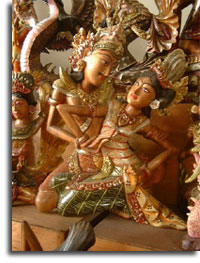|
 Arts
and Crafts Arts
and Crafts
Artistically
Bali is a melting pot of cultures and traditions. The Balinese
have a natural capacity for absorbing different cultural elements
to blend them with their own to produce dynamic new hybrids.
Over the years Bali has been the recipient of numerous influences;
Chinese, Buddhist, Indian, Hindu, Javanese and most recently,
Western. For centuries artists and craftsmen in Bali worked
under the patronage of the priests and ruling classes, decorating
palaces and temples. The artists themselves were anonymous,
never signing their work and usually living close together
in artists' 'villages'.
Although
highly skilled, Bali's carvers, sculptors, weavers and painters,
who decorate the island's temples and palaces, were never
paid for their work, and would earn their living as farmers
or traders, just like everybody else. They worked as artists
only when summoned by the raja or the high priest. By the
1930s, however, Balinese society was undergoing quite significant
changes. The rajas had lost a great deal of their power to
the Dutch colonials (many had in fact lost their lives, or
at least their homes), and foreign tourists were
gradually taking their place as patrons of the arts and paying
for the work. Over time, this encouraged a whole variety of
changes; artists began to carve and paint secular subjects,
to experiment with new material, to express themselves as
individuals and sign their own work. Making paintings and
carvings became a full time and relatively lucrative job,
and the arts and crafts industry is now one of the most profitable
on Bali.
Generally the artists did not have much room for personal
expression as their designs followed strict aesthetic and
religious guidelines. With the arrival of European artists
at the start of this century, this soon began to change and
artists started developing their own individual styles.
|



